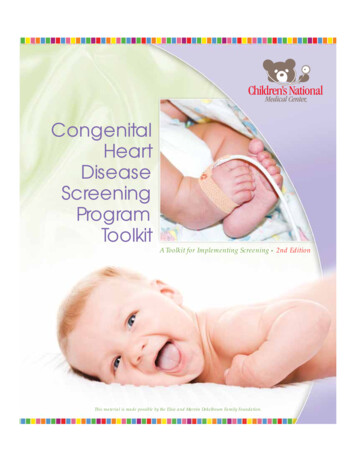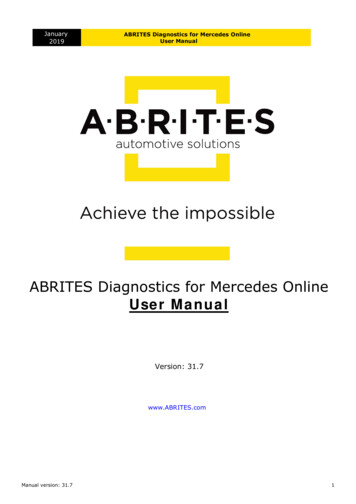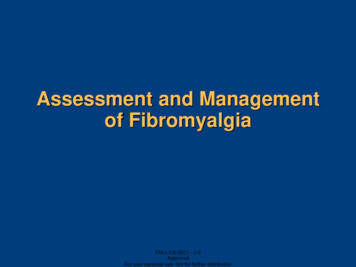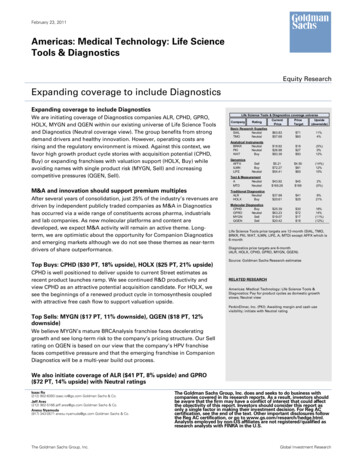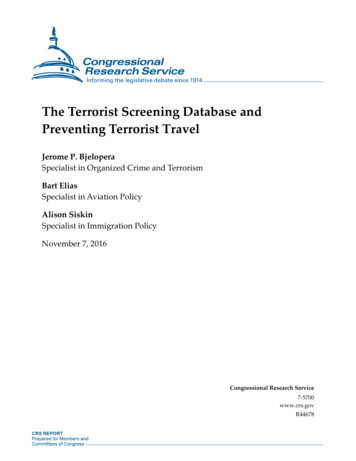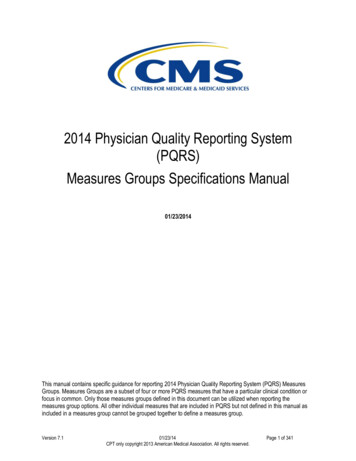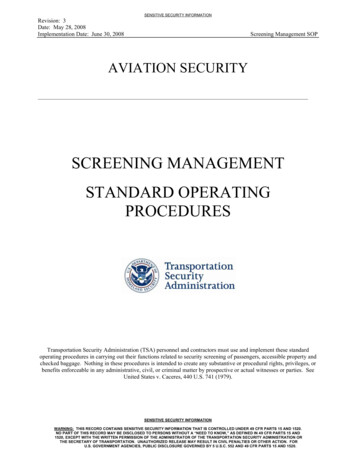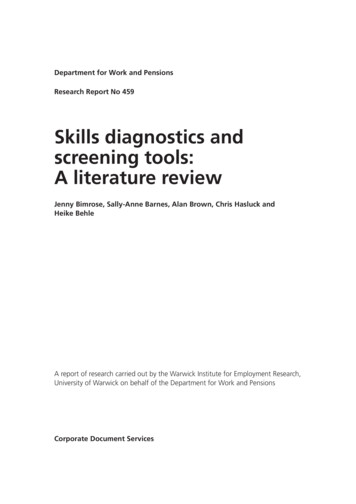
Transcription
Department for Work and PensionsResearch Report No 459Skills diagnostics andscreening tools:A literature reviewJenny Bimrose, Sally-Anne Barnes, Alan Brown, Chris Hasluck andHeike BehleA report of research carried out by the Warwick Institute for Employment Research,University of Warwick on behalf of the Department for Work and PensionsCorporate Document Services
Crown Copyright 2007. Published for the Department for Work and Pensionsunder licence from the Controller of Her Majesty’s Stationery Office by CorporateDocument Services, Leeds.Application for reproduction should be made in writing to The Copyright Unit,Her Majesty’s Stationery Office, St Clements House, 2-16 Colegate, Norwich NR3 1BQ.First Published 2007.ISBN978 1 84712 276 6Views expressed in this report are not necessarily those of the Department forWork and Pensions or any other Government Department.Printed by Corporate Document Services.
ContentsContentsAcknowledgements. xiThe Authors. viiAbbreviations and acronyms. ixGlossary of terms. xiSummary.1Introduction.1Aims of the literature review.1Main findings – skills review.2Main findings – screening tools.412Introduction.91.1Introduction.91.2Aims and objectives.91.3Review questions.101.4Report structure.11Skills review, identification, assessment and diagnosis.132.1Introduction.132.2Background .142.3Skills reviews, identification, assessment and diagnosis .172.4Skills appraisals for career progression .182.4.1Strong Interest Inventory and Skills Confidence Inventory.182.4.2Campbell Interest and Skills Survey.19iii
ivContents32.4.3Expanded Skills Confidence Inventory.202.4.4Kuder Career Search and Kuder Skills Assessment .202.4.5Task-Specific Occupational Self-Efficacy Scale.212.4.6Bilans de compétences.222.4.7Skills Diagnostic.222.5Other skills appraisals tools.232.6Examples of good practice that accommodate differentmodels of delivery.242.7Discussion.252.8Conclusions .282.9Summary.30Identification of customers/clients needing intensive .1Adviser discretion.433.2.2Eligibility rules.453.2.3Diagnostic or assessment tools.46Tools, methodologies and evidence of good practice.473.3.1Attitudinal screening.473.3.2Statistical modelling.483.3.3Other diagnostic .6Summary.63Appendix A Research process.65Appendix BDetails of electronic databases.77Appendix C Search results – skills review, identification, assessment anddiagnostic tools.83Appendix D Data extraction instrument for evidence on skills review,identification and diagnostics.87
ContentsAppendix ESearch results for literature on the identification of customersclients needing intensive support.91Appendix FData extraction instrument for evidence on screening tools andmethodologies for employment.97Appendix G Strengths and limitations of a systematic review process.101Appendix H Annotated bibliography for skills review, identification,assessment and diagnosis.105Appendix ISelected online skills assessment and diagnostic tools.115Appendix JAnnotated bibliography for screening tools andmethodologies for employment.123Appendix K Summary of recent developments in the German labourmarket.137References.141List of tablesTable 2.1Table C.1Table C.2Table E.1Table E2Summary of skills reviews, identification, assessment anddiagnosis tools.32Search strategy for literature on skills.83Number of references searched, included and excludedfor literature on skills review, identification, assessmentand diagnosis.85Search strategy for literature on the identification ofcustomers/clients needing intensive support.93Number of references searched, included and excluded forliterature on the identification of customers/clients needingintensive support.94v
AcknowledgementsAcknowledgementsWarwick Institute for Employment Research would like to thank the Departmentfor Work and Pensions (DWP) for commissioning this project.Due acknowledgement is given to the Evidence for Policy and Practice Informationand Co-ordinating Centre (EPPI Centre), part of the Social Science Research Unit atthe Institute for Education, University of London, for developing the underpinningprinciples and key concepts that have influenced the methodology used for thisreview.The review was carried out by a multi-disciplinary team of researchers from theWarwick Institute for Employment Research. Contributions were as follows:Dr. Jenny Bimrose, Principal Research Fellow, who was the project manager andlead writer.Dr. Sally-Anne Barnes, Research Fellow, who managed the review process and wasco-writer of this report.Professor Alan Brown, Professorial Fellow and Associate Director of the Economicand Social Research Council Teaching and Learning Research Programme, hasacted as critical reader for the report and provided a substantial input to thesection on one of his specialist areas, skills diagnostics.Chris Hasluck, Principal Research Fellow, has also acted as a critical reader for thereport and provided input to the section on one of his specialist areas, screeningtools.Dr. Maria de-Hoyos, Dr. Heike Behle and Lucy Marris undertook searches forthe review and data extractions. They also contributed to the development ofthe inclusion and exclusion criteria applied during the process of selecting texts.Heike Behle and Maria de Hoyos undertook searches and translations of materialswritten in Spanish, French and German. Maria Judice undertook the translation ofa Portuguese study.Jamie Brown, Duncan Adam and Elaine Shirt, Research Assistants, also undertooksearches and data extractions for the review.vii
viiiAcknowledgementsDr. Rachel Mulvey, University of East London, assisted with searches and translationsin French, plus data extractions.Sincere thanks to Thomas Rothe, Institut für Arbeitsmarkt und Berufsforschung,for his help in obtaining some of the German studies identified during the reviewprocess.The Steering Group convened for this project provided a great deal of practicalinformation and support to members of the research team, for which they aregrateful.Finally, sincere thanks go to Gillian Burgess, at the DWP, for her professional andconstructive overall project management.
The AuthorsThe AuthorsJenny Bimrose, Principal Research Fellow, Institute for Employment Research,University of Warwick.Sally-Anne Barnes, Research Fellow, Institute for Employment Research,University of Warwick.Alan Brown, Professorial Fellow, Institute for Employment Research, Universityof Warwick.Chris Hasluck, Principal Research Fellow, Institute for Employment Research,University of Warwick.Heike Behle, Research Fellow, Institute for Employment Research, University ofWarwick.vii
Abbreviations and acronymsAbbreviations and acronymsABSAAttitudes, Behaviours and Skills AssessmentALMPActive Labour Market PoliciesAMASActivity Matching Ability SystemBECESBarriers to Employment and Coping EfficacyScaleCFICareers Future InventoryCISSCampbell Interest and Skill SurveyCMSGCase Management Screening GuideCPKClient Progress KitCSESCareer Self-Efficacy ScaleESCIExpanded Skills Confidence InventoryFDSSFrontline Decision Support SystemFJRFortnightly Jobsearch ReviewIBIncapacity BenefitISIncome SupportJSAJobseeker’s AllowanceJSCIJob Seeker Classification InstrumentKCSKuder Career SearchKSAKuder Skills AssessmentLSILife Skills Inventoryix
xAbbreviations and acronymsMAPPMultidimensional Addictions andPersonality ProfileNAONational Audit OfficeNDYPNew Deal for Young PeopleOECDOrganisation for Economic Co-operationand DevelopmentPAPersonal AdviserPESPublic Employment ServicesSAPSStatistically Assisted Programme SectionSCISkills Confidence InventorySIIStrong Interest InventorySOMSService Outcome Measurement SystemTANFTemporary Assistance for Needy FamiliesTREFFERTreatment Effect and Prediction ProjectTSOSSTask-Specific Occupational Self-Efficacy ScaleUIUnemployment InsuranceWFIWork Focused InterviewWPRSWorker Profiling Re-employment Services
Glossary of termsGlossary of termsAcademic or ‘cognitive’ skillsGenerally associated with subject matterthese skill areas are typically defined by variousschool disciplines like English and mathematics.Knowledge is primarily learned in school andassumed to be transferable across differentcontexts. They are widely assessed throughstandardised tests.Blended assessmentThis refers to an approach to assessmentwhich combines traditional enced assessment involvesmeasurement against defined (and objective)criteria. Criterion-referenced assessment isoften, but not always, used to establish aperson’s competence (whether they cando something). The best known exampleofcriterion-referencedassessmentisthe driving test, when learner drivers aremeasured against a range of explicit criteria.DiagnosticsThis term refers to assessments providinginformation about a learner’s ability in a skill,level of knowledge in a subject and relevantpersonal characteristics. A diagnostic testshould provide feedback indicating areas ofgreater and lesser ability, rather than just agrade or mark. Diagnostic assessment typicallyoccurs before, or at the start of, a programme oflearning and enables learners to be providedwith or directed towards appropriatesupport.xi
xiiGlossary of termsFormative assessmentFormative assessment is carried out at thebeginning or during a learning programme.The purpose of this technique is to improvethe quality of learning and should not beevaluative or involve grading individuals. Itcan also be used to review and modifyprogrammes, where learning outcomes arenot being met, so can result in the improvementof the learning experience.Generic or key skillsThese are assumed to be transferable acrossa range of different contexts. In the UK, thenotion of ‘key skills’ was originally developedby the National Council for VocationalQualifications, with six skill areas identified:communication; application of number;information technology; working with others;improving own learning; and performanceand problem solving. These skills can,however, assume different meanings indifferent work contexts. For example, whereas‘problem solving’ is often associated withmathematical problems, it can also be appliedmore generally.Norm-referenced assessmentNorm-referenced assessments are notmeasured against defined criteria. This type ofassessment is relative to a target groupof individuals undertaking the assessment.It is effectively a way of comparing individuals.The IQ test is the best known example ofnorm-referenced assessment.ProfilingA statistical systems approach that computesonly a single risk factor for each person, whichis usually the probability of becominglong-term unemployed.SkillThis term is variously described as: the ability to perform a task or activityconsistently over a period of time. Theexpertise required for a particular task oroccupation which may include manualdexterity and/or mental aptitude; a present, observable competence of acandidate to perform a learned act withease and precision;
Glossary of terms Statistical modellingthe ability to perform a task or activityconsistently over a period of time. Theexpertise required for a particular task oroccupation which may include manualdexterity and/or mental aptitude;an elementary action requiring manual orverbal dexterity that is necessary forperforming a compound or complex set ofactions in order to accomplish a particulartask; the ability to do something wellarising from training or practice; ‘knowhow’.Statistical modelling provides a means ofassessing a jobseeker’s need for support onthe basis of a prediction of their futuresituation. Such a statistical model consists,first, of a target, or dependent, variableThis could be the predicted length of timeout of work, the customer’s risk of exhaustingbenefit entitlement, their labour marketstatus at some future date or similar.Second, a set of explanatory variables thatare believed to be determinants of, orat least associated with, the target variableis required. These would include personalcharacteristics of customers, work and benefithistories and other factors associated withemployability. Statistical techniques are thenused to estimate the relationship betweentarget and explanatory variables usinghistorical or cross-sectional data for the targetand explanatory variables. The estimatedrelationship can then be used to ‘predict’the expected outcome for any new customergiven their particular characteristics andcircumstances. Such predictions can be usedto identify customers in most need of supportand/or for determining the type of supportmade available. For instance, those at highrisk of remaining unemployed (say for 12months) might be identified as being in greaterneed of support than those predicted to beat little risk. Needless to say, statisticalmodelling of this type can be complex andxiii
xivGlossary of termsmodels vary considerably in the way that theyare specified and the methods used toestimate them. The technical aspects ofstatistical modelling are reviewed in Appendix Aof Hasluck (2004).Summative assessmentSummative assessment is comprehensive innature, provides accountability and is usedto check the level of learning achieved at theend of a learning programme. It is evaluativeand often involves grading. Data fromformative assessment can contribute tosummative assessment.TargetingThis approach to statistically modellingattempts to predict the potential labourmarket outcomes of every individualprogramme(includingnon-programmeoptions) for each individual.Technical skillsRefers to specific skills needed in a particularoccupation. These may include referencesto academic skills (e.g. maths needed byplumbers) or knowledge of particularprocesses (e.g. use of a particular machine).They are often codified in industry skillstandards and measured through standardisedassessments.Work-related attitudes or‘soft’ skillsThese are the most difficult groups of skills todefine, since there is no one generally acceptedway of conceptualising them. The term canrefer to motivation or disposition and oftenrelates to a combination of personal attributesand abilities that contribute to overallemployability (e.g. enthusiasm; reliability;sense of humour; adaptability; ability to takeinitiative; planning; organisation).
SummarySummaryIntroductionA key recommendation from the Leitch review of skills is the establishmentof a national network of one-stop shops for careers and employment advice,achieved through close collaborative working relationships between a new serviceand Jobcentre Plus. The new service is to offer a free ‘skills health check’ andis to become the source of skills expertise for Jobcentre Plus. In parallel withthis development, the Department for Work and Pensions (DWP) is developingthe Flexible New Deal, which involves examining the need to achieve a betterunderstanding of the circumstances of each customer. As part of these processes,the DWP commissioned the Warwick Institute for Employment Research toexamine available evidence relating to the review, identification, assessmentand diagnosis of skills, together with good practice, tools and methodologiesidentifying customers requiring more intensive support.Aims of the literature reviewThe aims of this study were, therefore, twofold, with a remit to identify and reviewthe research and evidence on two separate, but related, areas: skills appraisals to help identify and measure individual skills levels (includingthose skills needed by employers); and screening methodologies that help recognise influences on employability(including individual lack of skills).A systematic review methodology, modified to allow researcher discretion,was used to search databases to ensure that the searches across the electronicdatabases were consistent.The initial search strategy for the first review question on skills yielded 29,677hits. Of these, 579 publications were screened by abstract and title. In total, 29relevant studies were retrieved from electronic databases, ProArbeit (Germanlabour market database) and online searches. These studies were synthesised1
2Summaryaccording to emergent themes relating to the main review question and subquestion. Particular emphasis has been given in this review of skills to identifyingtools developed for measuring skills and, also, reviewing the evidence relating tothe use and effectiveness of such tools.For the second review question, the initial search strategy yielded 81,455 hits. Ofthese, 1,131 were screened by abstract and title. In total, 40 studies were retrievedand integrated into this review. As with the first review question, particularemphasis has been given to publications presenting methodologies for which asound evidence base has been, or is being, developed.Main findings – skills reviewSearch results for this literature review revealed a recent proliferation of skillsappraisal instruments. Yet there has been limited practice in the assessment ofadult skills for employability, with no one suitable ‘off-the-shelf’ tool that can beidentified.This proliferation of skills tools has been fuelled, at least in part, by Governmentimperatives to drive up skill levels to increase economic competitiveness. Tools forthe review, identification, assessment and diagnosis of skills have therefore beendeveloped for varied purposes and for different target audiences. Funding forthe development of many tools has come from public sources (e.g. the EuropeanUnion; the Higher Education Funding Council) that have typically supported shortterm projects to address specific local, regional, educational or occupational needs.When funding ceases, development support for the tool also often ceases, withthe result that scrutiny of effectiveness – especially over a longer time frame – isoften lacking. Many available tools may, therefore, have considerable merit, butclaims to effectiveness have often not been validated.In addition to product development supported by public funding, there is also aflourishing commercial market. Robust evidence bases underpinning skills tools forthis review have been found more commonly in association with these commercialtools. In these cases, developing such an evidence base, which testifies to theefficacy of tools, may well be part of an investment decision that supports themarketing strategy for the product.Regarding skills specifically for career progression, there is agreement about thedesirability of appraising these alongside vocational interests. Five tools withwell-developed evidence bases, for the appraisal of skills and/or interests, havebeen identified. These are: the Skills Confidence Inventory (SCI) to be used inconjunction with the Strong Interest Inventory (SII); the Campbell Interest and SkillsSurvey (CISS); the Expanded Skills Confidence Inventory (ESCI); the Kuder SkillsAssessment (KSA) to be used alongside the Kuder Career Search (KCS); and theTask-Specific Occupational Self-Efficacy Scale (TSOSS). All have been commerciallyproduced in the United States.It is perhaps relevant to note that a review of career assessment tools for usewith disadvantaged groups found only a limited number which provided relevant
Summaryevidence of reliability and validity for these populations. Of those identified in thisreview, the SII, the SCI and the TSOSS met criteria indicating their appropriatenessfor use with these groups.The French ‘bilans de compétences’ is a well established and well known exampleof appraisal for career development, which includes skills assessment. This isdelivered nationally through a network of ‘Centres interinstitutionnels de bilan decompétence’ (CIBC) and comprises an individualised, face-to-face process whichlasts up to 24 hours. This model of provision has been adopted in other Europeancountries – specifically Switzerland, Belgium and the Czech Republic, with similarapproaches adopted in Italy, Bulgaria and the Netherlands. A similar approach isalso used in Canada, where a recent evaluation of its efficacy revealed encouragingresults.Many tools are now available online for self-administration, for use in groups orwith the support of a practitioner (i.e. tutors, trainers, careers and employmentpractitioners). Others are paper-based and like online versions can be selfadministered, or used as part of a one-to-one intervention or group work. Yetothers are available both as paper-based versions and online. Whilst the mosteconomical option will, undoubtedly, be the self-administration of these tools,evidence indicates that the most reliable results are obtained through facilitatedtools – especially where an action plan to develop skills is regarded as a desirableoutcome from the process of appraisal.The use of language around the implementation of tools for skills appraisal inpractice can be somewhat confusing, with the concept of skills itself contested.Recent lessons in the implementation of assessment frameworks, which includeskills, emphasise the importance of convincing both practitioners and managersof the value of the tools. Attending to the anxieties of users, who may associate askills appraisal with negative experiences of assessment, also emerges as anothercritical success factor in their effective implementation and use.If one purpose of an initial skills tool for a new adult careers service is to getusers to identify skills that need further development, as a prelude to agreeing toundertake particular learning actions, then some thought needs to be given towhat type of approach might be appropriate for those clients who have alreadyidentified that they wish to undertake further learning.Because the ability to act effectively to cope with particular problems or tasks iscontextual, it may be useful if any universal skills check focuses not just on thepossession of skills, but also on the context of use.It may also be useful to regard competence in skills as developmental, rather thanas something that can be achieved. Hence, one of the options in any skills checkmay be to develop further skills in areas that are already strong, in order to deepenexpertise.3
4SummaryAny appraisal of skills has to gather together information on skills not only drawnfrom a variety of sources but which operate at different levels of aggregation. Anapproach modelled on those tools that provide free text spaces for individuals toidentify their best ‘examples’ of particular skills may be advantageous to userssince it not only involves description of the use of skills in particular contexts butcan be updated as skills develop.Considering whether to support the idea of horizontal progression will also beimportant. In practice, ‘spiky profiles’ of skill are common – meaning that someskills may be much more developed than others. To become more skilled andeffective in terms of overall performance, it is often necessary for individuals topay attention to the development of skills they may well possess, but at lowerlevels of competence than others, as well as gaps.Any skills tool designed to build a learning culture within the context of careerprogression needs to recognise the importance of needs, motivation, knowledge,values and interests, as well as skills.As there is a tremendous richness to the type of learning activities individuals canundertake to develop their skills, any appraisal process needs to incorporate avision of what a culture of learning might look like.Main findings – screening toolsAn extensive literature emerged from the review on tools and methodologiesfor identifying clients requiring extensive support. Since the purpose of thesetechniques is to facilitate more effective and efficient adviser discretion, it is relevantboth to acknowledge the critical role played by the Jobcentre Plus Personal Adviserin this process of identification and to recognise the different roles and variedresponsibilities that place competing demands on an already highly pressurisedgroup of employees.The current ‘triggered’ approach to assessing customer need in Jobcentre Plushas the advantage that resources are directed only to those who have actuallyexperienced difficulty in obtaining employment. However, it may not be the mostefficient process because of the wide variation in the customers’ circumstancesand needs. Support offered early on might secure a more speedy return to work.Three broad approaches to the identification of customer need can be identified:complete adviser discretion; the application of rules binding adviser discretion;and the use of diagnostic tools to aid adviser discretion.Every EU member state uses some system of adviser (or case worker) resourceallocation, with adviser discretion being the dominant mechanism. Advantagesinclude it being flexible, individual and providing a ‘personal touch’. Disadvantagesinclude the risk of customers not being treated equitably and the quality of decisionsdepending too much on the expertise of the adviser. Evidence is mixed regardingits effectiveness, with some studies casting doubt on the overall effectiveness ofthis approach.
SummaryMost (if not all) public employment services limit adviser discretion by the useof eligibility rules. The bases for these rules vary and few studies have examinedexplicitly how well they identify customers need in Jobcentre Plus support. Becauseof the diversity of the population of customers, it is likely that eligibility rulesrepresent something of a blunt instrument in terms of securing a good matchbetween individual customers and existing provision.The use of diagnostic or assessment tools involves the application of some formof instrument to determine a customer’s situation or need. Their use representsan intermediate position between allowing advisers complete autonomy andexpecting them to operate with administrative rules that may be inflexible. Theyrepresent a systematic means of assessing need and can avoid the inconsistencyand error that may arise with adviser discretion. An additional advantage is t
2.3 Skills reviews, identification, assessment and diagnosis .17 2.4 Skills appraisals for career progression .18 2.4.1 Strong Interest Inventory and Skills Confidence Inventory .18 . a Portuguese study. Jamie Brown, Duncan Adam and Elaine Shirt, Research Assistants, also undertook searches and data extractions for the review.


